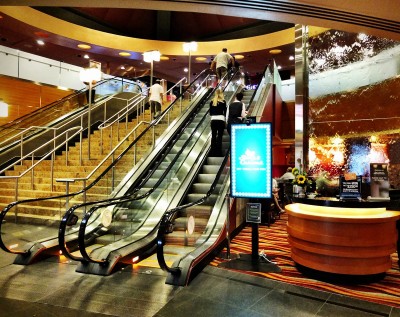Ontario casinos study digital signage

The results of a recent Ontario study of digital signage in casino environments, with regard to non-gaming sales and offers, showed the medium had a positive impact on food sales, but it was difficult to detect any measurable effect on loyalty program signups.
Conducted by Ontario Lottery and Gaming (OLG), Intel, Toronto-based Research Strategy Group (RSG), Capital Networks in Markham, Ont., and EdCom Multimedia Products in London, Ont., the project involved comparing casinos with digital signage, ‘static’ signage and no signage, respectively, over three periods. With this setup, it became possible to estimate the effects of digital signage in promoting free giveaways, restaurant menu items and OLG’s Winner’s Circle Rewards (WCR) loyalty program.
Four sites were chosen that had similar gambling offerings, including table games and slots. Two digital signs each were installed at Ontario’s Brantford Casino (pictured) and Thousand Islands Casino, a static sign (i.e. poster) was showcased at the Sault Ste. Marie Casino and no advertising was displayed at the Thunder Bay Casino.
Intel’s Audience Impression Metrics (AIM) Suite—originally developed in Toronto by CognoVision—was used to collect anonymous video analytics (AVA) about passersby looking at the digital screens and poster. This helped determine the optimal locations and content design.
The digital screens ran a continuous loop of spots for restaurant items (food and beverages), responsible gaming (with a tote bag giveaway) and the WCS program. On the poster, static versions of the same content were shown side by side.
The poster achieved the highest number of impressions during the first week, but then dropped and remained at lower levels during the rest of the test weeks. The two sites with digital signage achieved relatively stable impressions, fluctuating between 250 and 400 per day. The average exposure time per passerby tended to be two to three seconds, which emphasized the importance of designing content for ease of quick comprehension.
Many regular Brantford patrons said they did not notice the screens, while the ratio of impressions to number of patrons was higher at Thousand Islands, which is considered more of a ‘destination’ casino. This suggests digital signage may be more effective at reaching new customers.
The numbers of tote bag giveaways and selected menu item purchases were higher with digital signage than with ‘static’ or ‘no’ signage. For the loyalty program, however, there was no discernible pattern in the number of WCR signups with digital or static signage, which suggests they may not be as effective at more complex advertising that is not easy to act upon. That said, WCR was already heavily advertised through other media, including direct mail, but also other on-site posters and digital screens at the casinos.
OLG concluded advertising items on digital screens could boost sales—or in the case of the tote bags, free giveaways—so long as there was a clear ‘call to action’ for casino guests.


